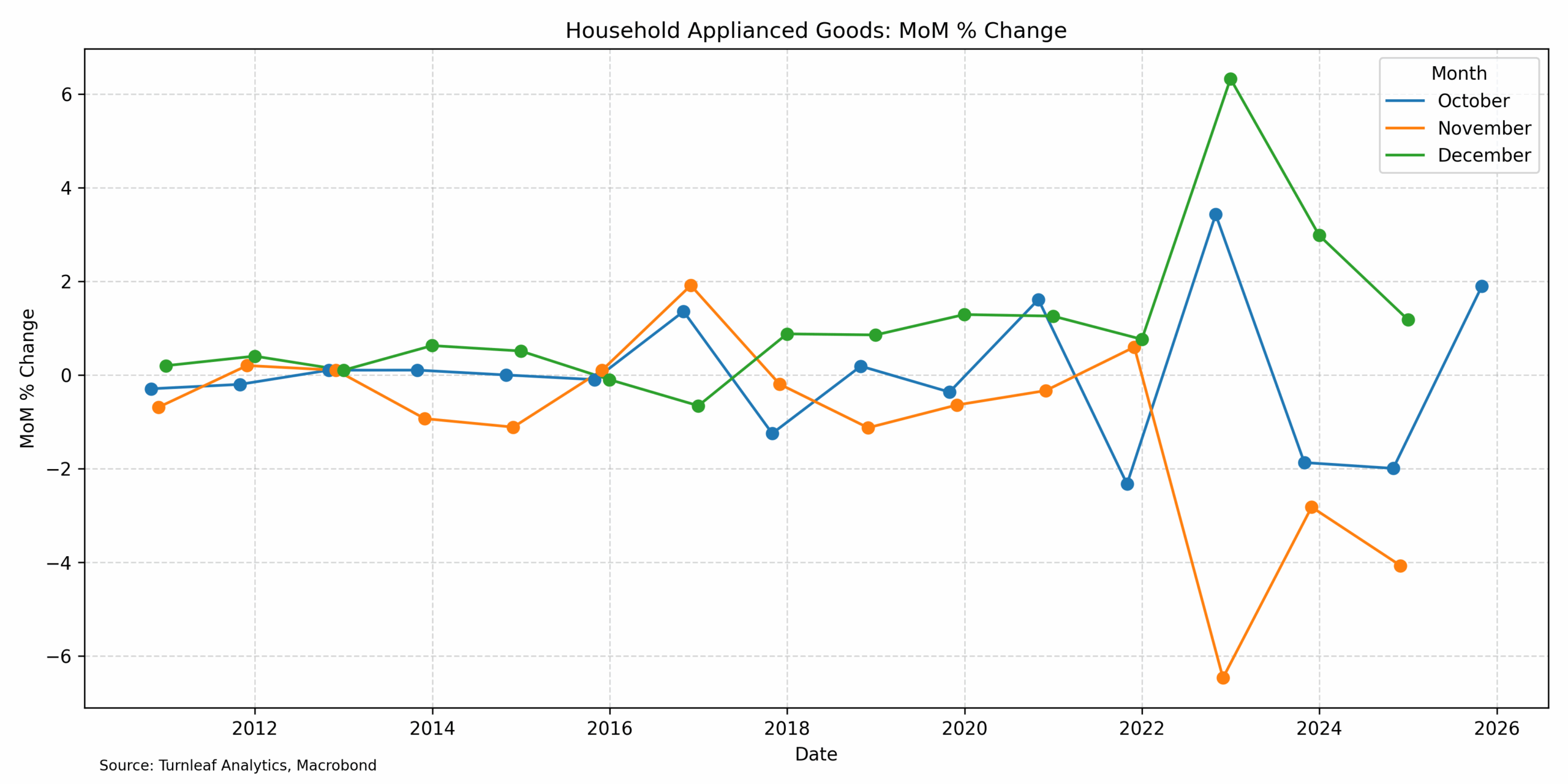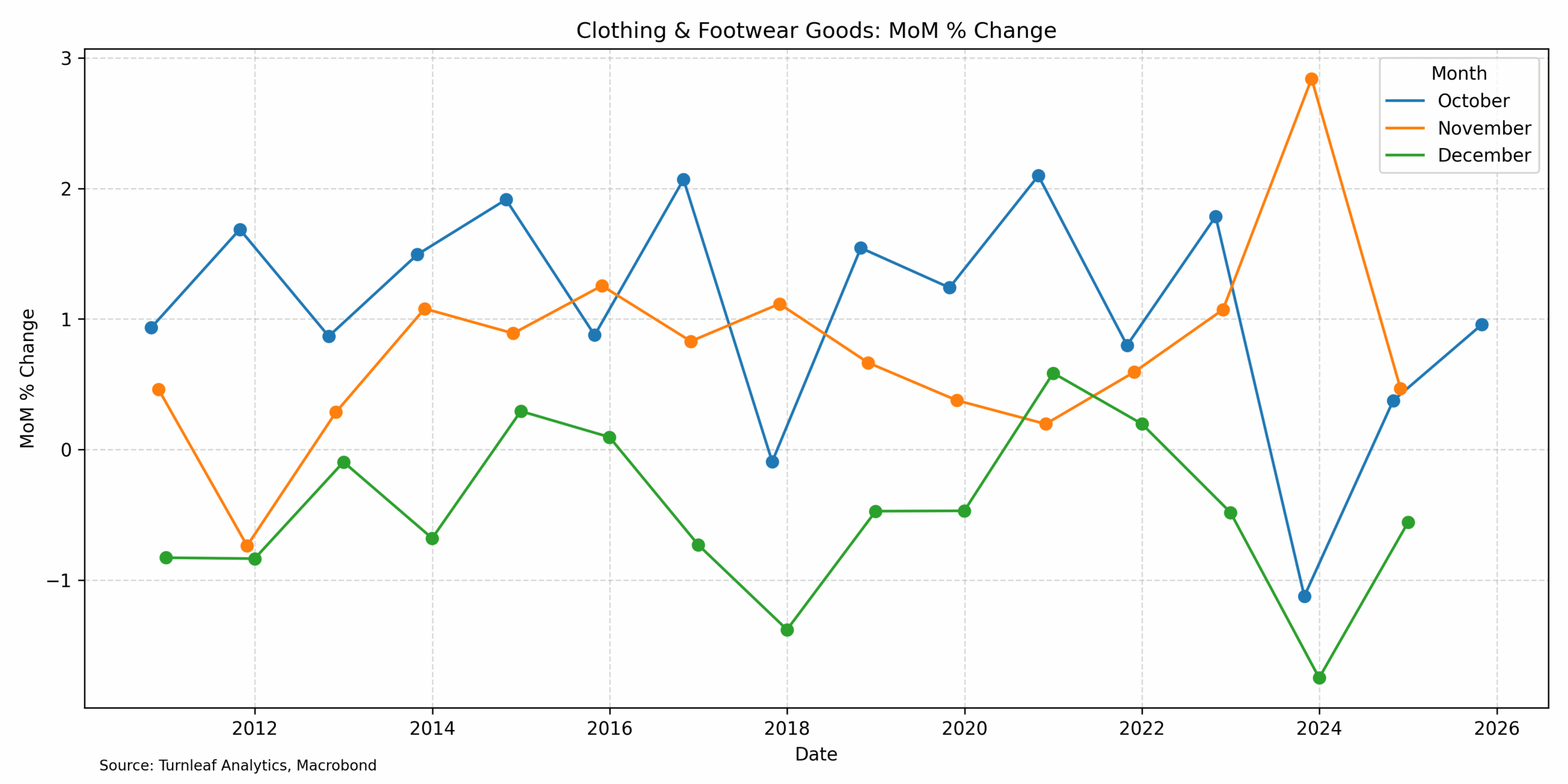Featured Research
Macroeconomic Insights: Norway CPI – Hey It’s Okay, Mistakes Happen
The Norway Statistical Institute recently revised the latest CPI print from 3.3% to 3.1%, correcting an error in electricity-price calculations that overstated inflation. Despite this adjustment, the institute maintained that the broader inflation picture, including...
Macroeconomic Insights: Norway CPI – Hey It’s Okay, Mistakes Happen
The Norway Statistical Institute recently revised the latest CPI print from 3.3% to 3.1%, correcting an error in electricity-price calculations that overstated inflation. Despite this adjustment, the institute maintained that the broader inflation picture, including core CPI, remained unchanged. For the October 2025 print, Turnleaf projected CPI to fall toward 3% YoY, accurately anticipating the effect of falling electricity prices by incorporating Turnleaf’s proprietary Electricity Price Index into its nowcasting framework (Figure 1).
Figure 1
 At the time of the nowcast, Turnleaf’s Electricity Index signaled a decline in Norwegian electricity prices, reinforcing the estimated impact of Norgespris, the newly introduced voluntary fixed-price scheme intended to reduce household electricity bills beginning in October 2025. The index’s broad coverage of power-price inputs ensured a representative series and allowed the model to capture the policy’s effect with greater precision.
At the time of the nowcast, Turnleaf’s Electricity Index signaled a decline in Norwegian electricity prices, reinforcing the estimated impact of Norgespris, the newly introduced voluntary fixed-price scheme intended to reduce household electricity bills beginning in October 2025. The index’s broad coverage of power-price inputs ensured a representative series and allowed the model to capture the policy’s effect with greater precision.
Turnleaf’s October 2025 estimate also incorporated a dedicated policy-impact analysis quantifying the combined influence of the Norgespris scheme and the reduced electricity tax. Looking ahead, Turnleaf anticipates some upward price adjustments in the coming months as suppliers partially counter the recent sharp declines, moderating the pace of the downturn in electricity prices.
Looking ahead to 2026, Turnleaf will incorporate additional budget-linked policy changes expected to influence inflation dynamics. These include (1) a lower EV VAT-exemption threshold, which is likely to exert upward pressure on prices given that EVs account for roughly 80% of Norway’s vehicle market, and (2) the unified electricity excise tax—roughly 12% of a household electricity bill—which is expected to push prices downward.
Changes in Seasonal Dynamics: Holiday Discounts
Local sources report that November’s Black Friday discounts are often preceded by pre-emptive price hikes in October, followed by price stability in December. A review of ten years of MoM data confirms stable seasonal patterns overall, with distortions emerging primarily in 2022 due to post-pandemic-related disruptions.
We do not expect these irregularities to materially alter the seasonal profile, but targeted monitoring is warranted for categories prone to opportunistic pricing, especially electronics such as mobile phones (Figure 2A) and household appliances (Figure 2B). Conversely, clothing and footwear (Figure 2C) continue to show muted seasonal effects and even recorded a YoY decline of –1.5% in October 2025, an improvement from –2.1% in September 2025.
Figure 2A

Figure 2B

Figure 2C

Turnleaf’s Outlook
Turnleaf’s ability to ingest and structure alternative, high-frequency data, notably granular electricity-price series and policy-linked inputs, provides a material forecasting edge in Norway’s CPI. Turnleaf expects Norway inflation to fluctuate between 2-3%YoY over the next 12 months with a possibility for a slight downward bias given the official correction of the latest CPI print downwards. Our Core CPI forecasts will remain unaffected by the revision and we continue to predict inflation hovering closer to 3%YoY.
By directly accounting for shifts in regulatory schemes, market pricing, and seasonal distortions via high-frequency data and features derived by our LLM models, Turnleaf is positioned to anticipate inflation inflection points well before official releases – even when official sources make a mistake. We will incorporate the revision soon, and republish our most recent forecast for Norway.
Research Archive
Flash Inflation Outlook: The Cost of Stability, Poland’s Extended Energy Caps
The Polish government’s decision to extend the cap on electricity prices at 500 PLN/MWh is a critical measure to limit inflationary pressures on households. To understand its...
Macroeconomic Insights: A Pinch of Real Rates, a Dash of Slack: Turnleaf’s 2025 U.S. Inflation Recipe
At Turnleaf Analytics, leveraging our machine learning models, we project U.S. inflation to stabilize between 2–3% through 2025, shaped by the interplay of import inflation,...
Macroeconomic Insights: Rising Costs Hit Germany Where It Can’t Afford It—Manufacturing
Germany, long regarded as Europe’s economic powerhouse, owes much of its success to its export-driven industrial base. However, recent years have seen this foundation weaken...
Macroeconomic Insights: France’s Inflation Outlook Amid Fiscal and Economic Pressures
France’s inflation remains near the European Central Bank’s (ECB) 2% target despite significant fiscal spending during the pandemic and in response to the war in Ukraine....
Flash Inflation Outlook: South Korea Inflation Amid Political Instability
South Korea’s brief declaration and subsequent revocation of martial law by President Yoon has damaged investor confidence, further weakening the won and placing pressure on the...
November 2024 Global Inflation Call: Transcript
Global Inflation Amid Trade Uncertainties Good afternoon and welcome to Turnleaf’s global inflation call. For the past month, global inflation expectations have been shaped by...
Takeaways from QuantMinds 2024 in London
Over the past years, the quant industry has changed substantially. My first visit to Global Derivatives was just over a decade ago. At the time, perhaps unsurprisingly, the...
Macroeconomic Insights – Poland’s Fight with External and Domestic Demand
As Poland navigates a complex economic landscape, its rapid growth, fueled by competitive wages and strong manufacturing, faces challenges from both domestic and external...
Takeaways from Web Summit 2024
Think of Lisbon and no doubt it’ll conjure images of explorers setting sail in centuries past across the ocean, the hills that climb across the city, pastel de nata and salted...
Macroeconomic Insights: UK Autumn 2024 Budget and Global Trade Pressures Add to Inflation Challenges
The UK government's Autumn Budget for 2024, introduced on October 30, is designed to enhance public services through increased capital investments, funded by higher taxes along...
Macroeconomic Insights: U.S. Inflation Outlook Under Another Trump Presidency
As U.S. economic conditions continue to evolve, Turnleaf will actively monitor inflation trends and publish regular updates to keep you informed. Our focus remains on leading...
Macroeconomic Insights: Turkey’s Two-Front Fight with Inflation and the Lira
Turkey’s central bank has adopted a stringent monetary policy to combat inflation, a stark departure from previous unorthodox strategies. With borrowing costs now at a benchmark...
Inflation Outlook for Canada in October 2024- Producer Optimism, Consumer Pains
Canada’s inflation outlook is shaped by a complex mix of declining energy costs, rising food prices, and evolving trade dynamics. At Turnleaf Analytics, we’re closely tracking...
How Bad is Too Bad? Japan’s Reckoning with Inflation and New Leadership
Japan’s battle with inflation has become a key issue, reshaping public sentiment and influencing recent election results. With the Liberal Democratic Party (LDP)–Komeito...
Turnleaf’s Inflation Outlook for Brazil: Rising Costs Amid Currency Pressures
Turnleaf’s Brazil’ inflation outlook for the next 12 months has undergone an upward revision, driven by several significant factors. While shipping costs have eased, inflationary...